transport systems
migration and its influence on the community
language
demand
labour requirement and timing of labour demand
decision making pattern
fish feed (quantity and seasonal variation)
First Version of Extension Pamphlet
| Selection of the site | ||
| You must choose a good place to put your fishpond | ||
| Choose a sunny place near water such as a stream or a spring, or in marshy ground where the water in the soil wil fill up your pond. | ||
| The soil in the place you choose must be good for a fishpond. | ||
| Do not choose a site with holes or cracks, anthills or rocks or with roots of trees or large bushes. The water will seep through the holes and cracks or along the roots and rocks. It will be very difficult to make the bottom watertight. |  | |
| To test if you have good soil, take a handful of soil from the surface, make it a little wet and squeeze it into a ball. |  | |
| Throw the ball into the air and catch it. | ||
| If it sticks together it is good soil and it will hold water. Wet and swampy grounds are usually good for pond construction. |  | |
| Bad soil with sand or gravel in it will not stick together and will not hold water. | ||
| Now dig a hole as deep as your waist and test the soil from the bottom of the hole in the same way as before. | ||
| You should make a second test to be sure that the soil is good. |  | |
| Early in the morning you fill the hole you dug with water. Fill it to the top. | ||
| By the evening some of the water will have sunk into the soil. Then fill the hole again with water. Cover the hole with leafy branches. | 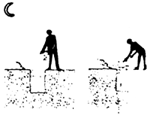 | |
| The next morning if most of the water is still in the hole, the soil will hold enough water to build a fishpond there. |  | |
Graphics were based on conventional illustrative tools such as arrows, cross-sections, and a work process shown in separate stages. People were depicted in an abstract way. Farmers found these drawings confusing; it prevented them from understanding the message.
Second Version of Extension Pamphlet
| Selection of the site | Kusanaka Malo abwino oeungilapo nsomba | |
|---|---|---|
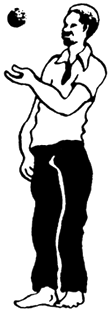 | You must choose a good place to put your fishpond. | Muyenela kusanaka malo abwino oikapo damu lansomba. |
| Choose a sunny place near the water such as a streamer a spring, or a marshy ground where the water in the soil will fill up your pond. | Sankani malo pamene pali madzi kapena kumball kwa mutsinje kapena malo amene asunga madzi kwanthawl yaithali. | |
| The soil in the place must be good for fish ponds. | Dothi loyenela kunkhala labwino losunga madzi. | |
| Do not choose with holes or cracks, anthills or rocks or with roots of trees or large bushes. The water will seep through the holes and cracks or along the roots and rocks. It will be very difficult to make the bottom waterweight. | Musanseke malo amene apezeka ndi mililo, kapena chulu, kapena midzu ya mitengo iliyonse. Cifukwa madzi yangadzipita momwemo mumipata yace. Ici chilengesa kunkhala chobvuta kuti asungidwe. | |
| To test if you have good soil, take a handful of soil from the surface, make it a little wet and squeeze it into a ball. | Kudziwa kuti dothi lanu ndilabwino, muligwile mumanja lamene lili ndi munyoto ndi kulinkanya kulipanga ngati mupila. | |
| Throw the ball in the air and catch it. | Muponye mumwamba ndi kungwilanso. | |
| If it sticks together it is good soil and it will hold water. Wet and swampy grounds are usually good for pond construction. | Linkhala longwilina pamene mwaligwilanso, chisonyeza kuti dothi ndi labwino. Lingasunge madzi. Malo amene ankhala ndi madzi kwa thawi ithali dyomalo abwino a damu lansomba, monga malo amumandambo. | |
| Bad soil with sand or gravel will not stick together and will not hold water. | Dothi loipa lamuchenga kapena lamyala silingwilana ndipo silisunga madzi. | |
| Now dig a hole as deep as your waist and test the soil from the bottom of the hole in the same way as before. | Nsono kumbani dzenje lanu kukwanila muchiuno chanu. Ndipo mutenje dothi lochonka pansi pa dzenje ndi kulichtha monga mwamene ndakamba poyamba. | |
| You should make a second test to be sure that the soil is good. | Muyenela kuchita chiyenso chawiri kuti musumikize kuti dothi ndi labwino. | |
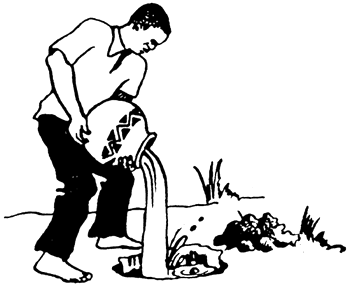 | Early in the morning you fill the hole with water. Fill it to the top. | Mumawa thilani madzimu dzenje lamene munakumba kufikisa pamwamba. Mu madzulo muzapeza kuti madzi ayenda pansi. |
| By the evening some of the water will have sunk into the soil. Then fill the hole again with water. Cover the hole with leafy branches. | Muyenela kuikamo madzi ena kufika pamwamba. Mutenge Mayani ndikuika pamwamba. | |
| The next morning if most of the water is still in the hole, the soil will hold enough water to build a fish pond there. | Mumawa wake mukapeza kuti madzi yalimo mudzenje ndye kuti dothi ndilabwino kusunga madzi. Kuti mungakumbe damu lansomba pamalopo. | |
| It is clear that for a fish pond water should come into the pond. But for a good pond there should also be a possibility to empty the pond. | Ndi bwino kuti madzi yalowe mu damu lanu. Koma damu lanu liyenera kukhala ndiko chotsera madzi. | |
| This means cutting the dike on the lower side of the pond. This draining is necessary when you want to crop your fish, you let the water go out and collect all the fish. | Ndiye kuti muyenera kupwanya cipupa ca damu mbali yonsondoka, pamene mudzafuna kukolola nsomba zanu cifukwa madzi yadzachoka onse ndipo muzatha kugwira nsomba zonse. | |
| For a good pond which can be drained you should select a site in an area with a gently sloop so the water can run out of the pond when you break one of the dikes. | Mukhale ndi damu labwino lochotsa bwino madzi pamene mufana kukolola nsomba zanu. Muyenera kupeza malo yonsondoka kuti madzi yakazichoka bwino kopanda bvuto pamene mwapwanya cipupa. |
Third and Current Version of Extension Pamphlet
WHERE TO PUT YOUR FISH POND
You must choose a good place to put your fish pond.
KOMWE M'NGAIKE CHITSIME
M'yenela kutsankha malo yabwino yachitsime chanu.
Choose a sunny place near water such as a stream or a dambo area where the water in the soil will fill up your pond. It is best to choose a piece of land that has a gentle slope.
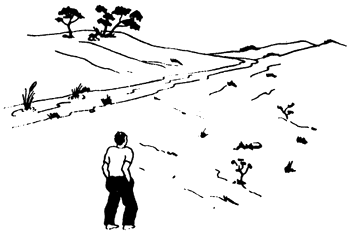
Sankhani malo abwino amene alandila dzuwa pafupi ndi madzi ambili. Ndipo pa msondo wabwino.
Like for making clay pots, you have to test if you have pond soil. You take a handful of soil from the surface, make it a little wet and squeeze it into a ball.
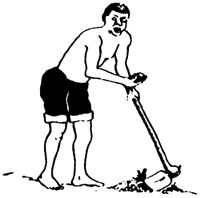
Dothi liyenela kukhala monga lopangila mbiya ndipo muyenela kuliyetsa. Tolani dothi kumanja ndikulibvumbwitsa, m'likanyekanye.
Throw the ball into the air and catch it. If it sticks together it is good soil and it will hold water.
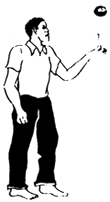
Muliponye m'mwamba ndikuliwankha. Ngathi lagwilana ndilabwino cifkwa lizasunga madzi.
Now dig a hole as deep as your waist.
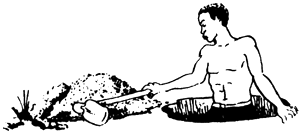
Kumbani dzenje kufika mchiuno.
Test the soil from the bottom of the hole in the same way as before.
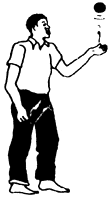
Yetsani dothi lapansi monga lapamwamba.
YOU SHOULD MAKE ANOTHER TEST TO BE SURE THAT THE SOIL WILL HOLD WATER.
M'MYENELA KUONETSETSA KUTI DOTHI LOSE NDILA BWINO LOGWILA MADZI.
Early in the morning you will fill the hole with water. Fill it to the top.

M'mawa-mawa mudzaze madzi mchitsime chanu mpaka palulu.
Cover the hole with branches. By the evening some of the water will have sunk into the soil. Then fill the hole again with water.
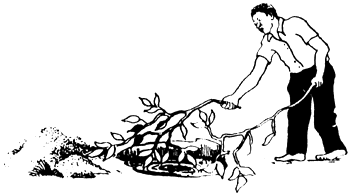
Ikamoni mitsambo ya mtengo m'chitsime kufika m'madzulo madzi ena adzaphwilila. Conco muikemo madzi ena.
If most of the water is still in the hole next morning, the soil will hold enough water to build a fish pond. Then, this is a good place to dig your pond.
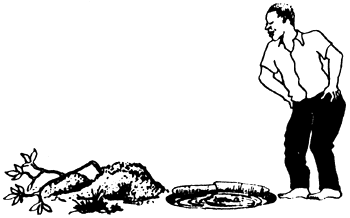
Ngati madzi ambili akalimo kufika m'mawa-mawa ndiye kuti dothi ndilabwino ligwila madzi. Ichi chitsonyeza kuti doti ndilabwino kukumbapo chitsime.
Farmer who takes 20 cm of topsoil and puts it aside. NOTE: from now on, every picture which shows an overview of pond in the area should also include the topsoil set aside.
Man digging with a hoe, woman transports dirt in basket to place where dikes will be built (topsoil has also been removed from places where dikes are going to be built).
Man compacting dike, using wooden earth stamper. Show clearly that there are heaps of soil which are being compacted.
Farmer pouring water on dikes using old tin or other container people would use in villages to water their vegetable garden.
Woman puts more soil on dike, man is compacting again. Show that there has been progress in digging and dike construction.
Show a pond where at least one well compacted dike with good slope (i.e. slope of roof) can be seen.
Show pond (more or less ready) and surrounding area in such a way that it becomes clear that area and pond are sloping. The deep end of the pond is at the lowest point of the area. The shallow part of the pond, at the highest point. Show a man standing in the shallow end, with water coming to his knees.
